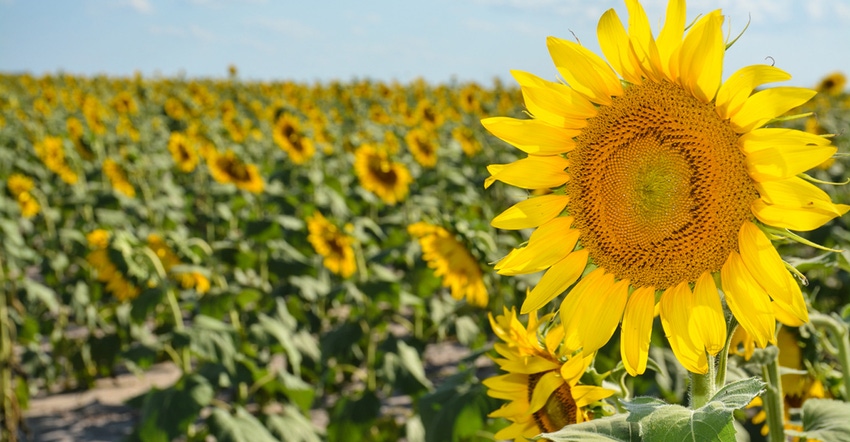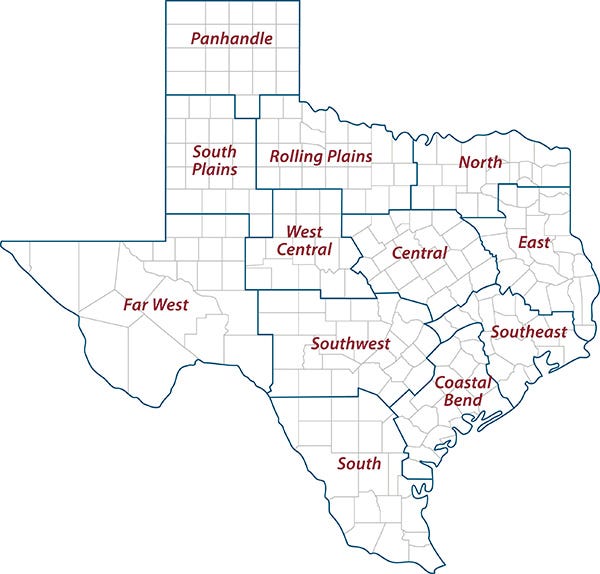
Alternative crop acres are expected to be up amid mixed market conditions, said Calvin Trostle, Texas A&M AgriLife Extension agronomist, Lubbock.
COVID-19 has not affected the market for alternative crops like sunflowers, sesame and guar, Trostle said. These crops are typically grown on rotation schedules for fields where cotton or row crops like corn and sorghum are grown.
But contract growers with buyers lined up have made alternative crops a way to add value to a farming practice meant to improve soils for their more traditional row or “money” crops, Trostle said.
“Overall, there have been some opportunities for growers looking to diversify cropping and their rotations with alternative crops,” he said.
Sunflowers
Trostle expects around 60,000 acres of sunflowers to be planted this season, up from 40,000 acres last year. He expects an additional 7,000 acres of sunflowers to be planted in the Rio Grande Valley to meet contract demand for confectionary seeds, those purchased to consume as a snack.
Two feet of snow at the wrong time set the 2019 North Dakota crop, which is second in U.S. sunflower production to South Dakota, back, he said. Quality was poor so North Dakota-based companies are contract-growing those additional acres in the Rio Grande Valley to make up for a bad harvest.
“A lot of confectionary acres are back,” he said. “Those acres will help relieve the shortage of quality confectionary sunflower seeds.”
Sunflowers are also processed as birdseed or mixed with various millet and sorghum varieties to create a colorful blend that consumers and birds find appealing, Trostle said.
Sunflowers can be planted later than other traditional crops in the Texas High Plains with harvest usually in October and November because they are cold hardy. Trostle said sunflowers can tolerate temperatures as low as 28 degrees for a few hours.
Guar
Guar experienced a tough 2019 and acreage should be similar in 2020, Trostle said. Prices have remained low since they ballooned in 2012.
Trostle expects between 15,000-20,000 acres to be planted. About 20,000 acres were planted last season.
Guar seeds produce a polymer gum used in oilfields, cosmetics and some foods, Trostle said. It experienced a bump in demand as fracking emerged as a cost-effective way to regenerate abandoned oil wells.
But the U.S. market has been depressed due to low-priced imports. Annual guar imports valued at $1 billion in 2011 are now valued at $300 million-$400 million.
AgriLife Extension has been working with the U.S. Department of Agriculture to develop a crop insurance program for guar growers that could make the crop a better alternative rotation crop.
“The Southern Plains have the processing capacity for 60,000-70,000 acres, but prices need to rise before that happens,” Trostle said. “Being able to insure the crop would also add an incentive that would make guar an option for a lot of growers.”
Sesame
Sesame acres may increase over the 50,000 acres planted last year, Trostle said. The crop is the No. 4 oilseed worldwide, but traditional varieties, which shatter their seed, are difficult to harvest mechanically and are hand-harvested in most areas still.
Texas producers have a technological advantage over producers around the globe via improved non-shattering plant varieties and mechanical harvesting equipment that separate seeds from the pod with little yield loss.
Sesame is primarily utilized for confectionary purposes like hamburger buns and salad bars. But Trostle said markets are beginning to see more demand for sesame oil.
AgriLife Extension district reporters compiled the following summaries:

CENTRAL
The weather was windy with spotty showers. Some areas received 1 inch of rain while most parts of the district received none. Grazing pastures were being fertilized and sprayed for weeds. Hay, mostly cool-season grasses, was being cut. Corn was fertilized, and aflatoxin protection was being applied. Most corn fields were in good to excellent condition. Some corn and sorghum fields showed drought stress. A few corn fields were irrigated, and many more were being prepared for irrigation. Wheat was about two weeks from harvest. Weed control measures helped, but some insect pests were developing. Livestock were in good condition with plenty of grazing. Sorghum and cotton plantings appeared lower than expected, and there were reports of more late-planted corn emerging. Cotton was emerging despite widespread soil crusting conditions. Cotton was mostly at first leaf stage. Soil moisture levels were adequate in more than 80% of the reporting area. Overall crop conditions were fair to good.
ROLLING PLAINS
Areas of the district received a light rain and hail. Winter wheat harvest was ready to start as fields continued to mature. Cotton producers will begin planting soon. Ranchers continued moving cattle off wheat pastures.
COASTAL BEND
Drought conditions persisted. Windy weather and scattered rains up to 1 inch were received, but all areas needed more rain. Most crops, particularly corn, were showing drought stress. Most corn fields were silking. Ears were small, and below-average yields were expected. Windy conditions delayed herbicide applications. Early planted rice fields were being flooded. First generation pecan nut casebearer spraying was complete. So far, the pecan crop looked good. Rangeland and pastures continued to decline from lack of moisture. Hay was becoming more difficult to find as people were holding on to inventories. Cattle remained in good condition.
EAST
Warmer, dryer weather made it possible for producers to begin cutting hay in some counties. Other areas, like Marion and Smith counties, received more rain. Marion County producers were having difficulty accessing pastures. Pasture and rangeland conditions were good. Subsoil and topsoil conditions were adequate. Wheat looked fully matured and ready for harvest. Producers began harvesting squash, cucumbers and green beans. Cattle prices were low. Livestock were in fair to good condition. Wild pig activity caused damage throughout the district.
SOUTH PLAINS
Dry conditions continued across the district. Warm temperatures and strong winds continued to dry topsoil. Rain was in the forecast. Farmers pre-irrigated for cotton planting. Producers were waiting for soil temperatures to warm before planting cotton. Corn was still being planted and continued to emerge across the district. Some winter wheat was harvested for forage. Rangeland and winter wheat were in fair condition. Cattle were in good condition.
PANHANDLE
Northern parts of the district reported short to adequate topsoil and subsoil moisture. Central parts reported short topsoil and subsoil moisture levels, and southern areas reported very short topsoil and subsoil moisture. Pasture and rangeland conditions were poor to good. Winter wheat conditions were fair to good. Most wheat fields were headed. Some producers continued to cut wheat for hay. Around 90% of corn planting was complete. Early planted corn had emerged with the help of irrigation. Cotton planting began.
NORTH
Topsoil moisture levels were mostly adequate with some reports of surplus moisture. Rain amounts were 1-2 inches with very high winds. Low temperatures dropped to the mid-60s. Ryegrass was being cut. Winter wheat was doing well. All the wheat was headed and looked good. Corn had emerged and was doing well. Livestock were in good condition. Spring-born calves looked good. Producers reported good supplies of cool-season forages. Horn flies were a problem early, and many producers were implementing control methods.
FAR WEST
High temperatures averaged in the low 100s with lows in the upper 40s. No precipitation was reported. Winds averaged 30 mph with gusts up to 50 mph. Soil moisture was being depleted due to temperatures and high winds. Several small grass fires caused by lightning were contained. Winter wheat and oats were grazed out. Some cotton was planted. Corn and sorghum were holding on, but fields were wind burned. Watermelons were starting to grow. Alfalfa looked very good, even though some producers lost a first cutting to alfalfa weevils. Pastures were very dry. Producers were monitoring for pecan nut casebearers and prepared to spray. Spring calf roundups continued, and producers were selling some of their calf crop, but most were holding on for better prices. Rangeland grazing was limited, but still enough to support livestock.
WEST CENTRAL
Conditions were dry and windy with no rain. Soils were beginning to dry out. Weeds were requiring management to get warm-season forages off to a good start. Livestock were in good condition with very little supplemental feeding. The calf market was a little better, $3-$5 higher per hundredweight, at the sale barn. Prices for slaughter bulls and cows were steady.
SOUTHEAST
Rangeland, pasture and hayfield conditions were very good. Small garden crop conditions were good, and no issues were reported. Nights were cooler. Rain was in the forecast. Rangeland and pasture ratings were excellent to poor with good being most common. Soil moisture levels ranged from adequate to surplus with adequate being most common.
SOUTHWEST
Moisture conditions continued to decline with above-average temperatures and windy conditions. Crops and pastures were beginning to show signs of drought stress. Some producers were cutting and bailing hay. Wheat was being harvested. Spring shearing continued, and lambs and kids were doing well. Overall, livestock and wildlife were in fair to good shape. Cattle prices were static to lower with normal goat prices starting to soften due to a larger supply.
SOUTH
Weather was mild to warm with short to very short soil moisture levels. Most areas reported very short soil moisture levels. Cool temperatures were reported In Atascosa County. La Salle County reported 100-plus-degree days. Parts of Maverick County reported less than 1 inch of rain. Crops were progressing well. Strawberries were in the final stretch of their growing season, and fruit and vegetables were producing. Potato harvest continued. Irrigated wheat fields were beginning to mature. Some wheat and oat harvests were underway. Cotton planting continued, and the corn crop was in the silking stage. Pasture and rangeland conditions were fair to good, but some pastures were turning brown due to lack of moisture. Crops and Bermuda grass fields were under irrigation. Irrigated Coastal Bermuda grass fields were producing good hay bales. Sunflower fields planted as cover crops or for wildlife were growing well. Onion harvest was expected to begin soon. Prickly pears were in good condition, and some ranchers were burning them to allow livestock to eat them. Ranchers were culling their cattle herds before the hot summer months. Stock tanks continued to deplete. Round bales were selling for $75-$90 per bale. Cattle prices remained low. The Texas Animal Health Commission found cattle fever ticks in some areas of Jim Wells County.
Source: is AgriLife TODAY, which is solely responsible for the information provided and is wholly owned by the source. Informa Business Media and all its subsidiaries are not responsible for any of the content contained in this information asset.
About the Author(s)
You May Also Like




